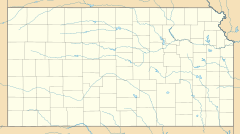McPherson Valley Wetlands facts for kids
Quick facts for kids McPherson Valley Wetlands |
|
|---|---|
| Location | McPherson County, Kansas |
| Nearest city | McPherson, Kansas |
| Area | 4,455 acres (1,803 ha) |
| Governing body | State of Kansas |
The McPherson Valley Wetlands are a special place in McPherson County, Kansas. They are a group of marshes, wetlands, and shallow lakes. These wetlands are not all connected, but they form a chain across the area. Long ago, they covered a much bigger space. As of 2011, about 4,455 acres of these wetlands and the nearby prairie have been saved. The Kansas Department of Wildlife, Parks, and Tourism helps protect them.
Contents
Discovering McPherson Valley Wetlands
The McPherson Valley Wetlands stretch for about 43 miles. They start northwest of McPherson, Kansas and go south towards Valley Center. In the late 1800s, there were 52 shallow marshes here. These marshes covered over 9,000 acres of water.
The biggest marsh was called Big Basin. It was more than 2,000 acres in size. None of these marshes were deeper than five feet. Many of them would dry up during the frequent droughts in the area. Two natural lakes, Lake Inman and Farland Lake, were also part of these marshes. Lake Inman is over 100 acres. It is the largest natural lake in Kansas. This lake is privately owned.
A Look Back: From Hunting to Farmland
At first, the wetlands were very important for people who hunted waterfowl. In the late 1800s, hunters caught thousands of ducks and other birds. They sent these birds by train to big cities like Kansas City and St. Louis.
Around 1900, most of the wetlands were drained. This was done to turn the land into farms. However, much of the land was too low and wet to be good for farming.
Bringing the Wetlands Back to Life
In 1989, the Kansas Department of Wildlife and Parks started buying back the old marshland. They began working to restore it to its natural state. They used levees, canals, and water pumps to bring the water back.
By 2011, they had bought 4,455 acres of land. This included 1,760 acres of wetlands that were restored. Some of the restored marshes include Big Basin, Kubin, Little Sinkhole, and Chain of Lakes. The state of Kansas continues to buy more land when it can.
Wildlife in the Wetlands
Before they were drained, the McPherson Valley Wetlands were a very important stop for migrating waterfowl. They were as important as Cheyenne Bottoms, another famous wetland 60 miles to the west.
More than 200 types of birds have been seen in these wetlands. This includes birds like the white-faced ibis, snowy plover, and peregrine falcons. Many different kinds of ducks also visit.
Rare Visitors to the Wetlands
In 1995, something special happened. For the first time in 100 years, whooping cranes visited the wetlands. These are very rare birds. In the spring of 2016, 17 whooping cranes visited the Big Basin marshes. In the summer of 2017, a beautiful roseate spoonbill visited the Little Sinkhole marshes.
Fun Activities at the Wetlands
The wetlands are open to everyone all year round. You can enjoy many activities here.
Hunting and Bird Watching
Hunting for waterfowl and upland game birds is allowed. You need a permit to hunt. Hunters must use steel shot for all hunting. Lead shot is not allowed. This rule helps keep waterfowl safe from eating lead while they are feeding.
Bird watching is another popular activity. Many people come to see the wide variety of birds.
Rules and Safety
Camping is not allowed at the wetlands. State Game Wardens regularly patrol the McPherson wetlands. They work for the Kansas Department of Wildlife, Parks, and Tourism. These wardens make sure everyone follows state laws. They also check hunters for their permits.


